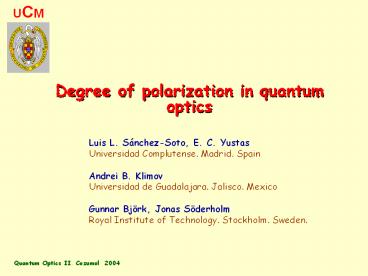Degree%20of%20polarization%20in%20quantum%20optics - PowerPoint PPT Presentation
Title:
Degree%20of%20polarization%20in%20quantum%20optics
Description:
A new proposal of degree of polarization. SU(2) coherent states. associated Q function ... The depolarized state in each su(2) invariant subspace is random ... – PowerPoint PPT presentation
Number of Views:306
Avg rating:3.0/5.0
Title: Degree%20of%20polarization%20in%20quantum%20optics
1
Degree of polarization in quantum optics
UCM
Luis L. Sánchez-Soto, E. C. Yustas Universidad
Complutense. Madrid. Spain Andrei B.
Klimov Universidad de Guadalajara. Jalisco.
Mexico Gunnar Björk, Jonas Söderholm Royal
Institute of Technology. Stockholm. Sweden.
Quantum Optics II. Cozumel 2004
2
Outline
UCM
- Classical description of polarization.
- Quantum description of polarization.
- Classical degree of polarization.
- Quantum assessment of the degree of polarization.
3
Classical description of polarization
UCM
- Monochromatic plane wave in a linear,
homogeneous, isotropic medium - E0 is a complex vector that characterizes the
state of polarization - linear-polarization basis (eH, eV)
- circular-polarization basis (e, e-)
4
Stokes parameters
UCM
- Stokes parameters
- Operational interpretation
5
The Poincaré sphere
UCM
- Coherence vector
- Poincaré sphere
6
Transformations on the Poincaré sphere
UCM
- Polarization transformations
- corresponding transformations in the Poincaré
sphere
7
Transformations on the Poincaré sphere
UCM
- Examples
- A differential phase shift induces a rotation
about Z - A geometrical rotation of angle q/2 induces a
rotation about Y of angle q
8
Quantum fields
UCM
- One goes to the quantum version by replacing
classical amplitudes by bosonic operators - Stokes parameters appear as average values of
Stokes operators - s is the polarization (Bloch) vector
- The electric field vector never
- describes a definite ellipse!
9
Classical degree of polarization
UCM
- Classical definition of the degree of
polarization - Distance from the point to the origin (fully
unpolarized state)! - Problems
- It is defined solely in terms of the first moment
of the Stokes operators. - There are states with P0 that cannot be regarded
as unpolarized. - P does not reflect the lack of perfect
polarization for any quantum state. - P1 for SU(2) coherent states (and this includes
the two-mode vacuum).
10
A new proposal of degree of polarization
UCM
A. Luis, Phys. Rev. A 66, 013806 (2002).
- SU(2) coherent states
- associated Q function
- Q function for unpolarized light
11
A new proposal of degree of polarization
UCM
A. Luis, Phys. Rev. A 66, 013806 (2002).
- Distance to the unpolarized state
- Definition
- Advantages
- Invariant under polarization transformations.
- The only states with P0 are unpolarized states.
- P depends on the all the moments of the Stokes
operators. - Measures the spread of the Q function (i.e.,
localizability)
12
Examples SU(2) coherent states
UCM
- Remarks
- 1 for all N.
- The case N0 is the two-mode
- vacuum with 0.
- In the limit of high intensity
- tend to be fully polarized
13
Examples number states
UCM
- Remarks
- For classically they
would be unpolarized! - The number states tend to be polarized when their
intensity increases.
14
Examples phase states
UCM
15
Drawbacks
UCM
- is intrinsically semiclassical.
- The concept of distance is not well defined.
- There is no physical prescription of unpolarized
light. - States in the same excitation manifold can have
quite different polarization degrees.
16
Unpolarized light classical vs. quantum
UCM
- Classically, unpolarized light is the origin of
the Poincaré sphere - Physical requirements
- Rotational invariance
- Left-right symmetry
- Retardation invariance
- The vacuum is the only pure state that is
unpolarized!
17
Alternative degrees of polarization
UCM
- Idea Distance of the density matrix to the
unpolarized density matrix - Hilbert-Schmidt distance
- Advantages
- The quantum definition closest to the classical
one. - Invariant under polarization transformations.
- Feasible
- Related to the fidelity respect the fully
unpolarized state.
18
A new degree of polarization (I)
UCM
- Any state
- can be expressed as
- Main hypothesis The depolarized state
corresponding to Y is
19
Properties of the depolarized state
UCM
- The depolarized state depends on the initial
state. - The depolarized state in each su(2) invariant
subspace is random - The extension to entangled or mixed states is
trivial.
20
Example
UCM
- States
- then
21
A new degree of polarization (II)
UCM
- Definition
- Pure states
22
Examples
UCM
- For any pure state in the N1 invariant subspace
- Quadrature coherent states in both polarization
modes
23
Conclusions
UCM
- Quantum optics entails polarization states that
cannot be suitably described by the classical
formalism based on the Stokes parameters. - A quantum degree of polarization can be defined
as the distance between the density operator and
the density operator representing unpolarized
light. - Correlations and the degree of polarization can
be seen as complementary.








![Get easy 1 year MBA degree in India Call {[969^090^0054]} MIBM GLOBAL PowerPoint PPT Presentation](https://s3.amazonaws.com/images.powershow.com/8832408.th0.jpg?_=20170505020)



![Contact {[{969:090:0054}]} 1 year MBA degree in India–MIBM GLOBAL PowerPoint PPT Presentation](https://s3.amazonaws.com/images.powershow.com/8832404.th0.jpg?_=201705050112)

![Get easy 1 year masters degree in India Call {[969^090^0054]} MIBM GLOBAL PowerPoint PPT Presentation](https://s3.amazonaws.com/images.powershow.com/8832050.th0.jpg?_=20170504071)
![Contact {[{969:090:0054}]} 1 year masters degree in India–MIBM GLOBAL PowerPoint PPT Presentation](https://s3.amazonaws.com/images.powershow.com/8832047.th0.jpg?_=20170504071)







![(MIBM GLOBAL ) 1 year MBA degree in India {[969-090^0054]} Number PowerPoint PPT Presentation](https://s3.amazonaws.com/images.powershow.com/8832396.th0.jpg?_=201705050111)
![(MIBM GLOBAL ) 1 year masters degree in India {[969-090^0054]} Number PowerPoint PPT Presentation](https://s3.amazonaws.com/images.powershow.com/8832040.th0.jpg?_=20170504071)






